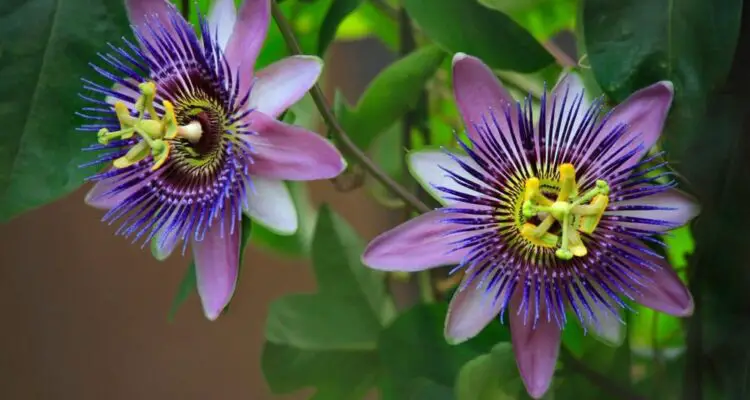Passion flower is a stunning vine known for its intricate blooms. Its vibrant flowers make it a favorite in gardens. Beyond beauty, it offers medicinal and ornamental value. Propagating passion flower allows gardeners to expand their collection naturally. Understanding propagation methods ensures healthy growth and abundant blooms.
This guide explores multiple propagation techniques. From seeds to cuttings, each method has unique advantages. Knowing the proper steps helps gardeners succeed in growing vigorous vines. Following expert tips ensures a thriving garden filled with passion flowers year after year.
Understanding Passion Flower

Passion flower, scientifically known as Passiflora, is a climbing vine with intricate, exotic flowers. Its blooms display vibrant colors and complex structures that attract pollinators. The plant thrives in tropical and subtropical climates but can adapt to temperate regions with proper care. Leaves, stems, and flowers contain bioactive compounds with calming effects, making it both ornamental and medicinal.
The vine exhibits a natural climbing habit and benefits from support structures like trellises or fences. Sunlight is essential for optimal growth, though some species tolerate partial shade. Well-draining soil prevents root rot and supports vigorous growth. The plant’s flowering season varies by species, with some blooming in spring and others throughout summer. Understanding its growth pattern helps gardeners plan propagation and care for maximum flowering success.
Passion flower has a rich history in traditional medicine. Indigenous peoples and herbalists have used it to alleviate anxiety, insomnia, and nervous tension. Modern studies confirm many of these benefits, showing that flavonoids and alkaloids in the plant interact with neurotransmitters to promote relaxation. Knowledge of its biological characteristics, environmental preferences, and historical uses provides a solid foundation for cultivating healthy vines. By understanding passion flower fully, gardeners and wellness enthusiasts can maximize its aesthetic, therapeutic, and ecological value in gardens and homes.
Benefits of Propagating Passion Flower
Propagating passion flower provides gardeners with the ability to expand their collection efficiently. More plants create a fuller, more vibrant garden display. It also allows for the preservation of specific cultivars with desirable traits, ensuring consistency in flower color, shape, and size. By multiplying existing vines, gardeners can save money and avoid purchasing new plants while enjoying the beauty of multiple blooms.
Propagation encourages plant resilience and health. Young plants grown from seeds, cuttings, or layering often develop stronger root systems. This process ensures that the new vines adapt well to garden conditions. Regular propagation also reduces the risk of plant loss due to age, pests, or disease. Expanding the population of passion flowers in a garden creates a sustainable and thriving ecosystem that supports pollinators and enhances overall biodiversity.
Additionally, propagating passion flower allows gardeners to experiment with various growth techniques. Different methods, such as seed germination, stem cuttings, or layering, provide flexibility in timing and effort. By understanding each propagation method, gardeners can plan for continuous blooms throughout the growing season. This approach ensures a steady supply of healthy plants ready for flowering, ultimately leading to a more dynamic and colorful garden. Successful propagation enhances both the aesthetic and functional value of passion flowers in any landscape.
Methods of Propagating Passion Flower
Propagation by Seeds
Growing passion flower from seeds is the most traditional method. Seeds should be soaked in water for 24 hours before planting. This softens the seed coat and improves germination. Sow them in well-draining soil, kept consistently moist but not waterlogged. Warm temperatures between 20–25°C encourage sprouting and early root development.
Seedlings develop slowly but form strong, resilient roots and stems. Germination may take two to six weeks depending on species and environmental conditions. Patience is essential, as flowering can take months. However, this method produces genetically diverse plants, enhancing resilience. Gardeners who invest time benefit from robust vines that can thrive under various conditions. Seed propagation is ideal for those seeking long-term results and expanding their garden sustainably.
Propagation by Cuttings
Stem cuttings offer a quicker way to propagate passion flower. Semi-hardwood cuttings, taken during active growth, root efficiently. Place them in a moist, well-draining medium to promote development. Maintaining warm, humid conditions prevents desiccation. Rooting hormones can further improve success rates, especially for delicate varieties.
Once roots establish, the new plants can be transplanted into garden beds. Cuttings replicate desirable traits from the parent plant, producing consistent flower characteristics. This method is faster than seeds, allowing blooms within the first growing season. Regular care, including proper watering and indirect sunlight, ensures healthy growth. Gardeners prefer cuttings when speed and uniformity are priorities.
Layering Techniques
Layering encourages root formation while the stem remains attached to the parent vine. Select a low-growing, flexible stem and bend it toward the soil. Cover part of the stem with soil and secure it with pins or stones. Keep the area moist to stimulate root development over several weeks.
Once roots develop, the new plant can be separated and transplanted. Layering reduces transplant shock and increases survival rates. It is ideal for slow-growing or delicate varieties that may struggle with cuttings. This low-maintenance approach allows gardeners to expand passion flower coverage naturally. Layering ensures vigorous plants ready to produce abundant blooms in the following season.
Choosing the Right Time for Propagation
Timing plays a crucial role in the success of passion flower propagation. Spring and early summer offer optimal conditions for rooting and growth. During this period, temperatures are warm but not extreme, which encourages rapid root development. Humidity levels are generally favorable, supporting cuttings, seeds, or layering techniques. Choosing the right season reduces stress on young plants and increases survival rates, ensuring vigorous vines ready to bloom in the garden.
Avoid propagation during extreme heat or cold periods. High summer temperatures can cause cuttings to dry out, while frost can damage tender seedlings. Winter propagation is challenging unless done indoors with controlled temperature and light. By aligning propagation activities with natural growth cycles, gardeners maximize the likelihood of successful establishment and strong flowering performance.
Local climate patterns should guide propagation schedules. In cooler regions, late spring may be better for planting seeds or taking cuttings, while in warmer climates, early spring is ideal. Monitoring soil temperature and moisture ensures plants are not exposed to stress. Careful planning of propagation timing allows gardeners to produce healthy passion flower vines efficiently. Proper timing ultimately leads to more abundant blooms and a thriving, colorful garden.
Preparing Soil and Containers
Healthy soil is essential for successful passion flower propagation. Well-draining, sandy-loam soil promotes strong root development. Enriching the soil with organic compost or aged manure improves fertility. Proper soil preparation ensures seedlings or cuttings receive sufficient nutrients for rapid growth. Avoid heavy clay soils, which retain water and increase the risk of root rot.
Containers should be clean and sterilized to prevent disease. Adequate drainage holes allow excess water to escape, preventing waterlogged conditions. Choose a container size that accommodates root expansion without overcrowding. Using shallow trays works well for seed germination, while deeper pots are suitable for cuttings and layering plants.
Maintaining consistent moisture is critical. The soil should be kept damp but not soggy. Mulching can help retain moisture and regulate temperature. Position containers in a warm, bright area with indirect sunlight to support healthy growth. Properly prepared soil and containers provide a strong foundation for young passion flowers, increasing the likelihood of successful propagation and vigorous flowering once transplanted into the garden.
Caring for Young Plants
Young passion flower plants require attentive care to thrive. Consistent watering is essential, keeping the soil moist but not waterlogged. Overwatering can lead to root rot, while drought stress slows growth. Position plants in bright, indirect sunlight to encourage healthy foliage and strong stems. Adequate airflow helps prevent fungal diseases and supports overall plant health.
Fertilization supports vigorous growth and future flowering. Use a balanced, slow-release fertilizer or organic compost during early growth stages. Avoid high-nitrogen fertilizers that encourage leafy growth over blooms. Regular monitoring of soil nutrients ensures young plants develop strong roots and stems capable of supporting heavy flowering in the future.
Pruning and pest management are crucial for maintaining plant health. Trim weak or damaged stems to encourage strong, upright growth. Inspect regularly for aphids, mites, or fungal infections. Early intervention prevents widespread damage and improves survival rates. With consistent care, young passion flower plants establish quickly, preparing them for successful transplantation into the garden and providing abundant blooms in the growing season.
Transplanting to the Garden
Transplanting young passion flower plants to the garden requires careful preparation. Choose a location with full sun or partial shade. Ensure the soil is well-draining and enriched with compost. Dig a hole slightly larger than the plant’s root ball to reduce transplant shock.
Handle plants gently when removing them from containers. Avoid damaging delicate roots and stems. Place the plant in the hole at the same depth as it grew in the container. Fill the hole with soil, lightly firming it around the roots to eliminate air pockets. Water thoroughly to help roots settle and reduce transplant stress.
After transplanting, maintain consistent care. Mulch around the base to retain soil moisture and regulate temperature. Monitor for pests and signs of stress, such as wilting or yellowing leaves. Providing support, such as a trellis or stakes, encourages climbing and flowering. Proper transplanting techniques ensure young passion flowers establish quickly and thrive, leading to robust growth and abundant blooms in the garden.
Supporting Growth and Encouraging Blooms
Passion flowers benefit from structural support to promote healthy growth. Trellises, fences, or stakes provide stability for climbing vines. Proper support prevents stems from breaking and encourages vertical growth. This allows better air circulation and light exposure, both crucial for vigorous blooming.
Regular pruning stimulates new growth and enhances flower production. Remove dead or weak stems to redirect energy to healthy shoots. Light trimming after flowering maintains plant shape and encourages successive blooms. Consistent pruning prevents overcrowding and reduces the risk of disease, ensuring a long-lasting, colorful display.
Fertilization and watering are key to sustaining blooms. Apply a balanced fertilizer during the growing season to support flowering. Maintain consistent moisture without overwatering, as passion flowers dislike soggy soil. Observing plant health, adjusting care, and providing optimal environmental conditions maximize bloom size, quantity, and longevity. Supporting growth effectively ensures abundant, vibrant flowers throughout the season.
Troubleshooting Common Problems
Poor Germination or Slow Growth
Seed germination can be affected by age, storage conditions, and soil quality. Using fresh seeds improves sprouting rates. Soak seeds for 24 hours in warm water to soften the coat and boost germination. Plant in well-draining soil kept evenly moist. Temperatures between 20–25°C create the optimal environment for young seedlings. Avoid waterlogged soil, which can lead to rot and fungal infections, slowing early development.
Slow growth may also result from inadequate sunlight or nutrient deficiencies. Place seedlings in bright, indirect sunlight for at least six hours daily. Enrich the soil with organic compost or a balanced fertilizer to supply essential nutrients. Monitor seedlings for signs of stress, including yellowing leaves or stunted growth. Patience is key, as passion flowers develop strong roots over time. Ensuring proper light, moisture, and nutrition helps seedlings grow into healthy, flowering vines ready for transplantation.
Pest Infestations
Aphids, spider mites, caterpillars, and scale insects often attack passion flowers. Regular inspections are critical, especially under leaves and along stems. Early detection prevents severe infestations. Signs include distorted leaves, sticky residue, or visible insects. Remove heavily infested areas to limit spread. Introduce beneficial insects, like ladybugs or predatory mites, to naturally control pests.
Natural remedies, such as neem oil or insecticidal soap, work effectively if applied consistently. Maintain proper plant spacing and airflow to discourage pest populations. Healthy, well-cared-for plants are more resistant to attacks. Avoid excessive nitrogen fertilizers, which can encourage soft, pest-attractive growth. Consistent monitoring, preventive measures, and prompt intervention help keep passion flowers thriving and free from pest damage.
Fungal and Root Problems
Fungal infections and root rot are common due to overwatering or poorly drained soil. Ensure containers or garden beds have sufficient drainage and use well-draining soil. Avoid overhead watering to reduce leaf disease risk. Mulch helps regulate soil moisture and temperature, protecting roots from extreme conditions.
If infection occurs, remove affected stems or leaves immediately. Mild fungicides may be necessary for severe fungal problems. Proper airflow, adequate sunlight, and consistent but moderate watering reduce fungal risks. Healthy roots and foliage support stronger growth, more vigorous flowering, and greater resistance to environmental stressors. Early attention to water management and disease prevention ensures passion flowers remain robust and productive.
Extending Blooming Season and Successive Flowering
Staggered Planting
Staggered planting is a practical strategy to maintain continuous blooms in a passion flower garden. By sowing seeds or taking cuttings every two to three weeks, gardeners create overlapping growth cycles. This approach ensures that as some flowers fade, others begin to bloom, maintaining color and vibrancy throughout the season. Careful planning helps prevent gaps in flowering and maximizes visual appeal.
Spacing plants appropriately is crucial to staggered planting success. Each vine requires adequate sunlight, nutrients, and airflow. Overcrowding can reduce flowering and increase the risk of disease. Monitoring soil moisture and plant development ensures all stages of growth thrive. By implementing staggered planting, gardeners can enjoy extended periods of vibrant passion flower blooms and a more dynamic, continuously colorful garden.
Regular Pruning
Pruning is vital to stimulate new growth and encourage successive blooms. Removing dead, damaged, or weak stems redirects the plant’s energy to healthier shoots. Light trimming after flowering promotes additional flowering cycles. Proper pruning enhances the overall structure, allowing vines to climb effectively on trellises or supports.
Pruning also improves air circulation and reduces disease risk. Crowded growth can block light, hinder flower development, and increase humidity around stems. By trimming carefully and consistently, gardeners can maintain an open, balanced plant structure. Regular pruning ensures longer flowering periods, more abundant blossoms, and a visually appealing, healthy passion flower garden throughout the season.
Fertilization and Care
Balanced fertilization is essential for continuous flowering. Applying a low-nitrogen fertilizer supports blooms rather than excessive leafy growth. Feed plants during early growth and just before flowering for optimal results. Organic compost or slow-release fertilizer improves soil fertility and encourages vibrant blossoms.
Watering and soil maintenance are equally important. Keep soil consistently moist but avoid waterlogged conditions. Mulching retains moisture, regulates soil temperature, and suppresses weeds. Combined with proper fertilization, attentive watering, and care, these practices help passion flowers sustain longer blooming cycles. Healthy plants produce abundant flowers, offering a garden filled with color throughout the growing season.
Caring for Mature Plants
Mature passion flower plants require consistent care to maintain health and flowering. Regular watering is essential, keeping soil moist but not soggy. Overwatering can lead to root rot, while drought stress slows growth and reduces blooms. Providing support, such as trellises or stakes, helps climbing vines maintain structure and prevents stems from breaking under their own weight.
Pruning remains important for mature plants. Remove dead, weak, or overcrowded stems to redirect energy to new growth. Light trimming after flowering stimulates additional blooms and keeps plants manageable. Proper pruning also improves airflow, reduces disease risk, and encourages a fuller, more vigorous appearance. Regular inspection for pests and fungal infections ensures early detection and treatment, maintaining plant vitality.
Fertilization supports mature plant performance and prolonged flowering. Use balanced, low-nitrogen fertilizer or organic compost to encourage blooms rather than excessive leafy growth. Apply nutrients during the growing season and just before flowering. Mulching helps retain soil moisture, regulate temperature, and suppress weeds. By providing attentive care, watering, pruning, and fertilization, mature passion flower plants remain healthy, resilient, and highly productive. This consistent maintenance ensures abundant, vibrant flowers and a flourishing, visually stunning garden throughout the growing season.
Propagation Troubleshooting and Tips
Seed Propagation Challenges
Growing passion flowers from seeds can be slow and unpredictable. Seed age and storage affect germination rates. Old seeds may sprout poorly or not at all. Soaking seeds in warm water for 24 hours before planting softens the coat and improves success. Plant seeds in well-draining soil kept consistently moist but not waterlogged. Temperatures between 20–25°C are ideal for germination.
Slow seedling growth may result from low light or nutrient-poor soil. Ensure seedlings receive at least six hours of indirect sunlight daily. Enrich the soil with organic compost to support healthy development. Patience is essential, as strong roots and stems take time to develop. Monitoring and adjusting light, moisture, and nutrients ensures seedlings grow into robust, flowering plants ready for transplanting.
Cutting and Layering Issues
Stem cuttings can fail to root due to dryness or low humidity. Semi-hardwood cuttings root best in moist soil with consistent humidity. Using rooting hormone improves success rates. Avoid exposing cuttings to direct harsh sunlight, which can cause wilting.
Layering may be slow for delicate varieties. Ensure the bent stem remains partially buried with good soil contact. Keep the soil evenly moist until roots develop. This technique reduces transplant shock and increases survival rates. Regular monitoring prevents the stem from drying out or rotting. Proper care during cutting and layering maximizes propagation success.
Pest and Disease Problems
Young plants and cuttings are vulnerable to aphids, spider mites, and fungal infections. Early detection is key to preventing severe damage. Inspect plants regularly, especially under leaves and along stems. Remove any affected areas promptly to limit spread.
Using neem oil or mild insecticidal soap controls pests naturally. Good airflow and proper spacing reduce fungal risks. Avoid overwatering, which can cause root rot or mold. Healthy, well-cared-for plants are more resistant. Consistent monitoring, preventive measures, and timely intervention ensure successful propagation and vigorous growth.
FAQ About How to Propagate Passion Flower
How long does it take for passion flower seeds to germinate?
Passion flower seeds typically take 2 to 4 weeks to germinate, depending on temperature and moisture. Soaking seeds in warm water for 24 hours improves germination rates. Providing well-draining soil, consistent moisture, and indirect sunlight ensures strong seedlings that develop healthy roots and stems ready for transplanting.
Can I propagate passion flowers from cuttings?
Yes, stem cuttings are an effective method. Semi-hardwood cuttings taken during active growth root quickly in moist soil. Using rooting hormone enhances success. Keep cuttings in warm, humid conditions, avoiding direct sunlight. Once roots form, transplant carefully to prevent shock and encourage healthy growth and faster blooming.
How often should I water passion flower cuttings?
Water cuttings regularly to keep the soil evenly moist but not waterlogged. Overwatering can cause root rot, while insufficient moisture slows rooting. Mist the cuttings or cover with a humidity dome if necessary. Proper hydration supports strong root formation and increases the likelihood of successful establishment.
What are common pests affecting passion flower propagation?
Aphids, spider mites, and scale insects commonly attack young plants and cuttings. Early detection is crucial. Inspect leaves and stems frequently. Natural remedies like neem oil or insecticidal soap help control infestations. Encouraging beneficial insects and maintaining good airflow reduces pest risks and supports healthy propagation.
How can I ensure continuous blooms from propagated passion flowers?
Stagger planting seeds or cuttings to create overlapping growth cycles. Regular pruning and removal of spent flowers redirect energy to new blooms. Adequate sunlight, balanced fertilization, and consistent watering support long-lasting flowering. Combining these practices ensures mature plants produce abundant, continuous blossoms throughout the growing season.
Conclusion
Propagating passion flower enhances garden beauty and bloom density. Seeds, cuttings, and layering offer versatile methods for expansion. Choosing the right time, preparing soil, and providing attentive care ensure success. Regular pruning, fertilization, and pest management promote healthy growth. By mastering propagation techniques, gardeners can enjoy abundant, vibrant passion flowers year after year, transforming their gardens into a lively and colorful retreat.






